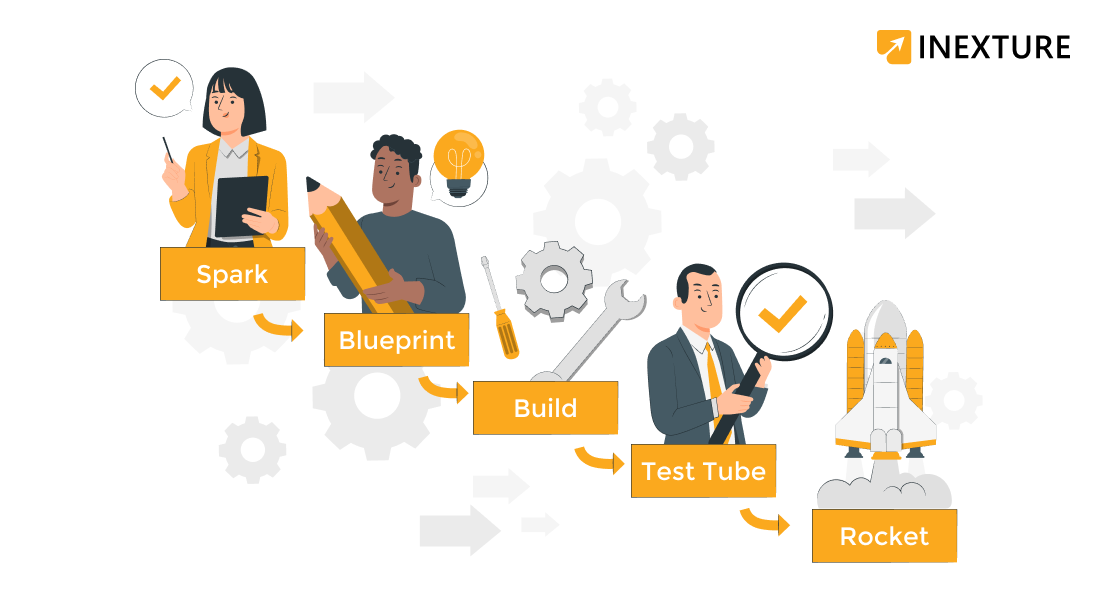Cost and Features to Build...
July 17, 2025

When it comes to managing projects or creating new products, the Stage Gate Process is imperative to have in place a clear process that helps you sift through the numerous ideas, and land on the best one. Project managers will usually be given the responsibility of determining the one to be launched, which one to improve, or how to make processes better.
This is where the Stage Gate system provides the solution. This is the approach that enables the managers to critically review each idea and move the ones that have potential to the actual development. This guide will cover the Stage-Gate Process in detail, explain its steps, give a few advantages this process can bring, and discuss how it is used so that projects can be successfully carried out.
The Stage Gate Process, also known as the Phase Gate Process, is the way to help project managers determine efficient stages of their work for introducing new products, improving processes, or making changes to a business.
This method divides a project into several parts, each ending with a “gate.” At these gates, important decision-makers like managers, board members, or a steering committee check how things are going.
They study the project’s plan, the resources needed, the risks involved, and what they expect to occur next. Such a careful finishing of every part guarantees that only the best and completely considered ideas go to the next step of the project. It’s important to be aware of this process to conduct projects of complex nature efficiently.
Learn More | Explore the System Development Life Cycle and Phases
The Stage Gate Process is a structured approach that project managers use to guide projects from conception to completion. Here are the key stages of the process:

This phase is about idea generation and finding the necessary information. This step contains sessions of ideation and research for the market and reviewing from different aspects such as consumers, associations, and product teams. Our aim would be to identify the best concept and cultivate it.
In addition, now one can likewise look at alternative operational models such as hiring remote development centers to trim the cost of operations. Workers can develop and maintain a diverse set of skills this way.
When that idea gets selected, the activities about it go into the scoping phase which is done for the purpose of viability assessment. This would be done by examining consumer demand, getting an understanding of any threats from potential competitors, and looking at the product idea’s strengths and weaknesses.
Networking sessions, internal marketing, and SWOT or PESTEL analysis are some of the strategies that they often employ. An execution plan would be formulated if indeed the idea is a valid one and a project detailed business case and plan would then be designed, ensuring all areas of the project are complete before the next step is taken.
This is where the development of the initial plan is practically happening. Among the most important components of the make-to-order method is the development process which comprises performing at pre-start, designing prototypes, and conducting a meeting with marketing persons so that they can work out a strategy that corresponds to the established goals.
It is paramount to ensure agreement of the initiative staying within the plan by scheduling meetings often while proposing suggested changes or changes.
The current day is the one when we are to go through the product with due diligence. A developmental stage applies to both the product and the processes involved, the customer’s approval, and the financial outcomes.
Testing may be lab-based (whether in an incubator or open field), or the product can go through the phase of field test and market trialing. This phase is significant and should be taken seriously to ensure the product conforms to the required standards and specifications, otherwise it will not encounter significant problems.
At the final stage, which is through all the obstacles, the product is introduced to the public. The start-up phase per se covers the approach of the marketing strategy, volume determination, and distribution planning. When a product has been post-launched, the feedback should be monitored, the reviews taken into account and the issues should be addressed as soon as possible.
Each of these stages involves critical decision points where stakeholders review progress and decide whether to proceed to the next stage, ensuring that resources are focused on the most promising projects.
Throughout this process, the major project is divided into steps that are easy to perform. Each step defines its own set of goals and work which makes team members spend time in the right direction and on things they have to do. Through this project, the team struggles to share common goals and remain focused on the subject.
This involves certain milestones or points once called gates, where there is a review for possible problems. Identifying these risks in the beginning makes it possible to address the issues before they are turned into problems, saving time and money, and maintaining the course of the project.
The Stage-Gate Process has well-organized stages that put to use resources such as time and money efficiently. The chances of a project getting more resources depend on how much potential is seen and how successful it is likely to become. With this, available resources will be used effectively and will be utilized in projects with the most potential, such projects will not be overlooked.
With careful checks at each gate, only the best projects move forward. This thorough examination reduces the chance of failure and increases the likelihood that the project will succeed and meet its goals.
This will entail organized and interactive communication among those who are part of the team, including leaders. Every gate is a space where we communicate with one another, listening to everyone to arrive at a consensus and ensure nobody is excluded or in the dark. With this collaboration, it is ensured that the project is in line with its objectives.
Overall, the Stage Gate Process offers a structured and clear pathway for projects from start to finish, making it easier to manage projects successfully and achieve the desired results.
The Stage Gate Process really helps projects succeed because it’s well-organized and quick at finding and fixing inefficiencies. This method makes decision-making smoother, ensures resources are used in the best way possible, and cuts down on risks and wasted effort.
By using this approach, businesses can shape their project management strategies to fit their specific needs and goals effectively. For instance, the custom mobile app created for Ernst & Young, developed by Inexture Solutions, which gave investors a way to adjust financial forecasts to their liking, shows how these specialized project management methods can solve specific problems and lead to better results.